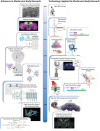What do the mushroom bodies do for the insect brain? Twenty-five years of progress
- PMID: 38862175
- PMCID: PMC11199942
- DOI: 10.1101/lm.053827.123
What do the mushroom bodies do for the insect brain? Twenty-five years of progress
Abstract
In 1998, a special edition of Learning & Memory was published with a discrete focus of synthesizing the state of the field to provide an overview of the function of the insect mushroom body. While molecular neuroscience and optical imaging of larger brain areas were advancing, understanding the basic functioning of neuronal circuits, particularly in the context of the mushroom body, was rudimentary. In the past 25 years, technological innovations have allowed researchers to map and understand the in vivo function of the neuronal circuits of the mushroom body system, making it an ideal model for investigating the circuit basis of sensory encoding, memory formation, and behavioral decisions. Collaborative efforts within the community have played a crucial role, leading to an interactive connectome of the mushroom body and accessible genetic tools for studying mushroom body circuit function. Looking ahead, continued technological innovation and collaborative efforts are likely to further advance our understanding of the mushroom body and its role in behavior and cognition, providing insights that generalize to other brain structures and species.
© 2024 Fiala and Kaun; Published by Cold Spring Harbor Laboratory Press.
Figures


Similar articles
-
Modelling the insect Mushroom Bodies: Application to sequence learning.Neural Netw. 2015 Jul;67:37-53. doi: 10.1016/j.neunet.2015.03.006. Epub 2015 Mar 27. Neural Netw. 2015. PMID: 25864122
-
Beyond prediction error: 25 years of modeling the associations formed in the insect mushroom body.Learn Mem. 2024 Jun 11;31(5):a053824. doi: 10.1101/lm.053824.123. Print 2024 May. Learn Mem. 2024. PMID: 38862164 Free PMC article. Review.
-
Mushroom bodies and reniform bodies coexisting in crabs cannot both be homologs of the insect mushroom body.J Comp Neurol. 2021 Aug;529(12):3265-3271. doi: 10.1002/cne.25152. Epub 2021 May 5. J Comp Neurol. 2021. PMID: 33829500 Review.
-
Insect societies and the social brain.Curr Opin Insect Sci. 2016 Jun;15:1-8. doi: 10.1016/j.cois.2016.01.010. Epub 2016 Feb 4. Curr Opin Insect Sci. 2016. PMID: 27436726 Review.
-
Contextual memory reactivation modulates Ca2+-activity network state in a mushroom body-like center of the crab N. granulata.Sci Rep. 2022 Jul 6;12(1):11408. doi: 10.1038/s41598-022-15502-1. Sci Rep. 2022. PMID: 35794138 Free PMC article.
Cited by
-
Analysis of molecular and cellular bases of honey bee mushroom body development.Sci Rep. 2025 Jul 1;15(1):21462. doi: 10.1038/s41598-025-06268-3. Sci Rep. 2025. PMID: 40596271 Free PMC article.
-
A neuromorphic model of active vision shows how spatiotemporal encoding in lobula neurons can aid pattern recognition in bees.Elife. 2025 Jul 1;14:e89929. doi: 10.7554/eLife.89929. Elife. 2025. PMID: 40589182 Free PMC article.
-
The Drosophila adult brain: short overview of structure, function, and resources Graphical Review Paper.Curr Res Insect Sci. 2025 May 15;7:100113. doi: 10.1016/j.cris.2025.100113. eCollection 2025. Curr Res Insect Sci. 2025. PMID: 40510592 Free PMC article. Review.
References
Publication types
MeSH terms
Grants and funding
LinkOut - more resources
Full Text Sources
Miscellaneous
